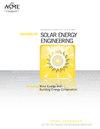风向对近距离运行短干式自然通风冷却塔制冷量的影响
IF 1.9
4区 工程技术
Q3 ENERGY & FUELS
Journal of Solar Energy Engineering-transactions of The Asme
Pub Date : 2023-08-31
DOI:10.1115/1.4063333
引用次数: 0
摘要
多个自然通风干式冷却塔的布局可能会对聚光太阳能发电厂冷却系统的性能产生重大影响,但这一点从未得到量化。因此,本工作使用计算流体动力学(CFD)建模来分析在一个公共场地上的两个短自然通风干式冷却塔(NDDCT)在一系列塔间距、风速和风入射角下的冷却能力。结果表明,塔架的冷却性能与塔架间距及其相对于风向的方位密切相关。研究发现,当风以90°的风入射角(即,垂直于两座塔之间绘制的线)时,当塔间距小于1.8塔直径(1.8D)时,它们的冷却能力得到了提高,尽管对于其他塔间距,塔之间没有相互作用。然而,当风与塔架成45°时,塔架周围的气流导致其冷却能力在1.8D和2.6D的塔架间距下降低。最有趣的是,研究发现,将塔架定向为与主导风向一致,可使冷却能力提高30%。这是由于迎风塔起到了被动防风的作用。因此,随着CSP发电厂容量的增加,需要额外的冷却塔,这些冷却塔应靠近任何现有的塔,并沿着盛行风的路线定向。本文章由计算机程序翻译,如有差异,请以英文原文为准。
The effect of wind direction on the cooling capacity of short dry natural draft cooling towers operating in close proximity
The layout of multiple natural draft dry cooling towers could have a significant influence on the performance of the cooling system in concentrated solar power (CSP) plants, however this has never been quantified. Hence, this work used computational fluid dynamics (CFD) modelling to analyze the cooling capacity of two short natural draft dry cooling towers (NDDCTs) on a common site for a range of tower spacings, wind speeds and wind incidence angles. The results show that the cooling performance of the towers is a strong function of tower spacing and their orientation with respect to the wind direction. It was found that when the wind came at a 90° wind incidence angle (i.e., normal to a line drawn between the two towers) that their cooling capacity was improved at tower spacings of less than 1.8 tower diameters (1.8D), though for the other tower spacings there was no interaction between the towers. However, with wind at 45° to the towers, the flow around the towers resulted in a decrease in their cooling capacity at tower spacings of 1.8D and 2.6D. Most interestingly, it was found that orienting the towers in line with the prevailing wind direction delivered improvements in the cooling capacity of up to 30%. This is due to the windward tower acting as a passive windbreak. Hence, as CSP plant capacity is increased, and additional cooling towers are required, these should be placed close to any existing tower and oriented along the line of the prevailing winds.
求助全文
通过发布文献求助,成功后即可免费获取论文全文。
去求助
来源期刊
CiteScore
5.00
自引率
26.10%
发文量
98
审稿时长
6.0 months
期刊介绍:
The Journal of Solar Energy Engineering - Including Wind Energy and Building Energy Conservation - publishes research papers that contain original work of permanent interest in all areas of solar energy and energy conservation, as well as discussions of policy and regulatory issues that affect renewable energy technologies and their implementation. Papers that do not include original work, but nonetheless present quality analysis or incremental improvements to past work may be published as Technical Briefs. Review papers are accepted but should be discussed with the Editor prior to submission. The Journal also publishes a section called Solar Scenery that features photographs or graphical displays of significant new installations or research facilities.

 求助内容:
求助内容: 应助结果提醒方式:
应助结果提醒方式:


